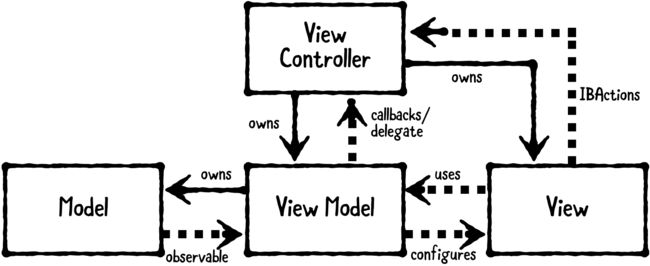Model-View-ViewModel(简称MVVM)是一种结构设计模式(structural design pattern),将对象分成三个不同的组:
- Models:持有用户数据。通常为 struct 或 class。
- Views:在屏幕上显示视觉元素和控件。通常为
UIView的子类。 - View models:将模型转换为可在视图上直接显示的值。为了方便传递时进行引用,通常为 class。
MVVM 和 Model-View-Controller(简称MVC)很像。上面 MVVM UML 图中包含视图控制器。也就是,MVVM 模式包含 view controller,只是其作用被弱化了。
在这篇文章中,将介绍如何实现 view model,并重构项目以使用 MVVM 模式。开始部分是一个关于视图模型的简单示例。最后,将获取一个 MVC 项目并重构为 MVVM。
1. 何时使用 MVVM 模式
当模型需要转换后才可以在视图显示时,使用 MVVM。例如,使用视图模型(view model)将Date转换为日期格式的String,将十进制转换为货币格式的String等。
MVVM 模式与 MVC 模式并无冲突。如果没有 view model 部分,则将 model-to-view 转换代码放到控制器。但视图控制器已经做了像视图生命周期、IBAction 处理视图回调等各种任务,低耦合变得难以实现。MVC 也就成为了 Massive View Controller。
如何避免过度使用视图控制器?可以在使用 MVC 模式之外,组合使用其他设计模式。Model-View-ViewModel就是其中之一。
2. Playground example
在 Xcode 中创建 playground。这部分示例将会创建一个宠物收养视图。
2.1 Model
Model 代码如下:
import PlaygroundSupport
import UIKit
// MARK: - Model
public class Pet {
public enum Rarity {
case common
case uncommon
case rare
case veryRare
}
public let name: String
public let birthday: Date
public let rarity: Rarity
public let image: UIImage
public init(name: String,
birthday: Date,
rarity: Rarity,
image: UIImage) {
self.name = name
self.birthday = birthday
self.rarity = rarity
self.image = image
}
}
这里声明了一个 Pet model,每个 pet 都有name、birthday、rarity、image四种属性。需要把这些属性显示到视图中,但birthday和rarity不能直接显示,需要使用 view model 进行转换。
2.2 ViewModel
ViewModel 代码如下:
// MARK: - ViewModel
public class PetViewModel {
// 创建两个属性,并在初始化方法中设值。
private let pet: Pet
private let calendar: Calendar
public init(pet: Pet) {
self.pet = pet
self.calendar = Calendar(identifier: .gregorian)
}
// 声明 name 和 image 为计算属性。
public var name: String {
return pet.name
}
public var image: UIImage {
return pet.image
}
// 计算属性转换后,将可以使用显示。
public var ageText: String {
let today = calendar.startOfDay(for: Date())
let birthday = calendar.startOfDay(for: pet.birthday)
let components = calendar.dateComponents([.year],
from: birthday,
to: today)
let age = components.year!
return "\(age) years old"
}
// 根据 rarity 决定价格。
public var adoptionFeeText: String {
switch pet.rarity {
case .common:
return "$50.00"
case .uncommon:
return "75.00"
case .rare:
return "150.00"
case .veryRare:
return "$500.00"
}
}
}
name和image直接返回,没有进行任何转换。若后期需要修改name(如添加前缀),可以直接在此修改。ageText和adoptionFeeText转换后直接返回需要显示的字符串。
2.3 View
View 代码如下:
// MARK: - View
public class PetView: UIView {
public let imageView: UIImageView
public let nameLabel: UILabel
public let ageLabel: UILabel
public let adoptionFeeLabel: UILabel
public override init(frame: CGRect) {
var childFrame = CGRect(x: 0,
y: 16,
width: frame.width,
height: frame.height / 2)
imageView = UIImageView(frame: childFrame)
imageView.contentMode = .scaleAspectFit
childFrame.origin.y += childFrame.height + 16
childFrame.size.height = 30
nameLabel = UILabel(frame: childFrame)
nameLabel.textAlignment = .center
childFrame.origin.y += childFrame.height
ageLabel = UILabel(frame: childFrame)
ageLabel.textAlignment = .center
childFrame.origin.y += childFrame.height
adoptionFeeLabel = UILabel(frame: childFrame)
adoptionFeeLabel.textAlignment = .center
super.init(frame: frame)
backgroundColor = .white
addSubview(imageView)
addSubview(nameLabel)
addSubview(ageLabel)
addSubview(adoptionFeeLabel)
}
@available(*, unavailable)
public required init?(coder aDecoder: NSCoder) {
fatalError("init?(coder:) is not supported")
}
}
这里创建了一个PetView,其有四个子视图。imageView显示宠物图片,另外三个 label 分别显示宠物name、age、adoption fee。最后,在调用init?(coder:)时抛出fatalError异常来表明不能使用该方法。
2.4 具体应用
现在,可以将其付诸实践。具体应用如下:
// MARK: - Example
let birthday = Date(timeIntervalSinceNow: (-3 * 86400 * 366))
let image = UIImage(named: "direwolf")!
let direwolf = Pet(name: "Direwolf",
birthday: birthday,
rarity: .veryRare,
image: image)
// 使用 direwolf 创建 viewModel
let viewModel = PetViewModel(pet: direwolf)
let frame = CGRect(x: 0,
y: 0,
width: 300,
height: 420)
let view = PetView(frame: frame)
// 使用 viewModel 直接显示
view.nameLabel.text = viewModel.name
view.imageView.image = viewModel.image
view.ageLabel.text = viewModel.ageText
view.adoptionFeeLabel.text = viewModel.adoptionFeeText
PlaygroundPage.current.liveView = view
要看具体效果,选择 View > Assistant Editor > Show Assistant Editor,运行后如下:
最后,还有一点可以改进。在PetViewModel类关闭花括号后添加以下扩展:
extension PetViewModel {
public func configure(_ view: PetView) {
view.nameLabel.text = name
view.imageView.image = image
view.ageLabel.text = ageText
view.adoptionFeeLabel.text = adoptionFeeText
}
}
现在,可以使用configure(_ view:)方法设置 view。
找到以下代码:
view.nameLabel.text = viewModel.name
view.imageView.image = viewModel.image
view.ageLabel.text = viewModel.ageText
view.adoptionFeeLabel.text = viewModel.adoptionFeeText
并用以下代码替换:
viewModel.configure(view)
这样可以把所有视图显示逻辑放到 view model 中。在实际应用中,是否这样操作需根据实际情况而定。如果只有一个视图使用此 view model,把configure(_ view:)方法放入视图模型中会很有用;如果有多个视图在使用此 ViewModel,把所有显示逻辑放到 view model 会让 view model 混乱。在这种情况下,为每个视图单独配置显示代码可能更为简洁。
点击https://github.com/pro648/BasicDemos-iOS/blob/master/Model-View-ViewModel获取这一部分的源码。
3. 使用 MVVM 重构已有项目
在这一部分,将为 MVVMPattern app 添加功能。
首先,在 github.com/pro648/BasicDemos-iOS/tree/master/MVVMPattern模版 下载这篇文章所需要的demo。MVVMPattern app 显示附近的咖啡店,数据由 Yelp 的 YelpAPI 提供,使用 CocoaPods 安装 YelpAPI。
如果你对 CocoaPods 不熟悉,可以查看CocoaPods的安装与使用、使用CocoaPods创建公开、私有pod这两篇文章。
在运行 app 前,需要先注册 Yelp API key。在浏览器打开 https://www.yelp.com/developers/v3/manage_app 网页,根据提示填写注册信息。将获取到的 key 粘贴到 Resources/APIKeys.swift 文件提示的位置。
运行后如下:
模拟器默认位置是 San Francisco,可以在模拟器菜单栏 Debug > Location 选择其他位置,也可以在 Xcode 调试区域直接选择其他城市。
地图上只显示图钉体验不好,直接显示咖啡店评分信息会更好。
打开MapPin.swift文件,MapPin类包含coordinate、title、rating三个属性,并对其进行转换以便 map view 可以直接显示。这里就是 view model 的功能。
首先,更改类名称。在 MapPin 上右键,选择 Refactor > Rename。新的名称为 BusinessMapViewModel,这样会同时修改文件名称和类名称,更改 Models 组名称为 ViewModels。更改名称后使用 Sort by name 对文件系统重新排序。如下所示:
这样能清晰表明你在使用 MVVM 模式。
BusinessMapViewModel需要更多属性才能显示更为有效的地图注释(map annotation),而非使用 MapKit 提供的普通图钉(pin)。
把BusinessMapViewModel.swift文件中的 import Foundation 替换为:
import UIKit
继续添加以下属性:
public let image: UIImage
public let ratingDescription: String
将使用image替换 MapKit 默认的图钉图片,并在用户点击 annotation 时以副标题的形式显示ratingDescription。
使用以下代码替换init(coordinate:name:rating:)方法:
public init(coordinate: CLLocationCoordinate2D,
name: String,
rating: Double,
image: UIImage) {
self.coordinate = coordinate
self.name = name
self.rating = rating
self.image = image
self.ratingDescription = "\(rating) stars"
}
通过初始化程序接受image,使用rating设置ratingDescription。
在MKAnnotation extension 添加以下计算属性(computed property):
public var subtitle: String? {
return ratingDescription
}
当点击 annotation 时,使用ratingDescription作为副标题。
进入ViewController.swift文件,使用以下代码替换addAnnotations()方法:
private func addAnnotations() {
for business in businesses {
guard let yelpCoordinate = business.location.coordinate else {
continue
}
let coordinate = CLLocationCoordinate2D(latitude: yelpCoordinate.latitude,
longitude: yelpCoordinate.longitude)
let name = business.name
let rating = business.rating
let image: UIImage
switch rating {
case 0.0..<3.5:
image = UIImage(named: "bad")!
case 3.5..<4.0:
image = UIImage(named: "meh")!
case 4.0..<4.75:
image = UIImage(named: "good")!
case 4.75..<5.0:
image = UIImage(named: "great")!
default:
image = UIImage(named: "bad")!
}
let annotation = BusinessMapViewModel(coordinate: coordinate,
name: name,
rating: rating,
image: image)
mapView.addAnnotation(annotation)
}
}
addAnnotations()方法与之前没有太大区别,只是添加了 switch 评分,以决定使用那张图片。
如果此时运行 app,你会发现 map view 没有任何变化。这是因为需要在代理方法中提供自定义的 pin,annotation image 才可以显示。
在addAnnotations()方法下面添加以下方法:
public func mapView(_ mapView: MKMapView, viewFor annotation: MKAnnotation) -> MKAnnotationView? {
guard let viewModel = annotation as? BusinessMapViewModel else {
return nil
}
let identifier = "business"
let annotationView: MKAnnotationView
if let existingView = mapView.dequeueReusableAnnotationView(withIdentifier: identifier) {
annotationView = existingView
} else {
annotationView = MKAnnotationView(annotation: viewModel, reuseIdentifier: identifier)
}
annotationView.image = viewModel.image
annotationView.canShowCallout = true
return annotationView
}
上述代码创建了MKAnnotationView,用以显示 annotation 图片。
运行 app,可以看到自定义 annotation,点击 annotation 可以看到咖啡店名称和评分。
点击 https://github.com/pro648/BasicDemos-iOS/tree/master/MVVMPattern 获取重构后源码。
总结
以下是 Model-View-ViewModel 模式的关键点:
- MVVM 有助于减少视图控制器功能,使其易于使用、维护。避免 Massive View Controller 的出现。
- View models 类能够将对象转换为其他类型对象,将转换后的对象传递到视图控制器并显示在视图上。这对于将像
Date、Decimal类型 computed property 转换为类似于String类型,并直接显示到UILabel、UIView中特别有效。 - 如果只有一个视图使用该 view model,可以将所有配置放入视图模型;但是,如果多个视图使用该 view model,将所有显示逻辑放到 view model 可能使其混乱不堪。此时,将显示逻辑放到视图中更为简洁。
- 如果 app 刚开始开发,MVC 可能是一个更好的起点,后续可以根据 app 需求的变化选择不同的设计模式。
Demo名称:MVVMPattern
源码地址:https://github.com/pro648/BasicDemos-iOS
参考资料:
- Design Patterns by Tutorials: MVVM
- Model–view–viewmodel
- Introduction to MVVM
欢迎更多指正:https://github.com/pro648/tips/wiki




